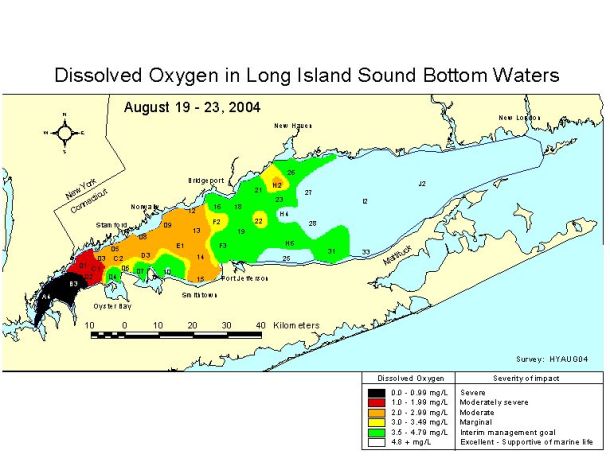Water quality in Long Island Sound as measured by dissolved oxygen levels is better than it has been during any other mid-July period in almost a quarter of a century.
For the first time since monitoring began in 1991, researchers found oxygen levels above 3.5 milligrams per liter in the bottom waters throughout the entire Sound during their regular mid-July testing.
And, equally encouraging, it was only the second time that mid-July readings showed oxygen levels above 3 everywhere in the Sound (2004 was the other year).
 Three milligrams per liter is the threshold of hypoxia, a warm-weather problem caused by nitrogen, mainly from treated sewage. Excess nitrogen in the Sound spurs the growth of algae which, when they die and decompose, use up dissolved oxygen. Lack of oxygen is extremely detrimental to habitat for fish, crustaceans, and other creatures. Hypoxia strikes the western half of the Sound and is the ecosystem’s most critical ecological problem.
Three milligrams per liter is the threshold of hypoxia, a warm-weather problem caused by nitrogen, mainly from treated sewage. Excess nitrogen in the Sound spurs the growth of algae which, when they die and decompose, use up dissolved oxygen. Lack of oxygen is extremely detrimental to habitat for fish, crustaceans, and other creatures. Hypoxia strikes the western half of the Sound and is the ecosystem’s most critical ecological problem.
So a July with no hypoxia is good news. But, as we’ll show, based on what happened in 2004, there are reasons to hold off on the celebration for a while.
Since 1991, CT DEEP has been measuring dissolved oxygen, and it has also been trawling for fish. Each time it hauls up the trawl, it weighs what’s in the net – a measurement called biomass. Then it compares the biomass with the amount of dissolved oxygen in the water.
The resulting correlation demonstrates how hypoxia results in impaired habitat and less biomass.
The DEEP has learned that when dissolved oxygen falls below 4 milligrams per liter, there is a 2 percent drop in biomass. That’s not so bad. But from there it gets worse, fast.
When dissolved oxygen falls below 3, the biomass reduction is 41 percent. When it falls below 2, the reduction is 82 percent. And when it falls below 1 milligram per liter, the reduction is 100 percent – no fish can live where dissolved oxygen is below 1.
Water quality that bad is common in the western half of the Sound in July and August. Just two years ago, for example, more than 20 percent of the Sound suffered from hypoxia, and about 18 square miles – between Westchester and Nassau counties – had readings below 1. This was one of the worst hypoxic years ever.
So why is this year different so far? Hard to say for sure but it probably has something to do with water temperature and nitrogen levels.
Long Island Sound is cooler than usual this year, and cold water holds more dissolved oxygen. In fact, mid-July water temperatures were cooler in only two other years since 1991.
Another difference is nitrogen. More than two decades ago, when researchers and government regulators confirmed that nitrogen was the key cause of hypoxia, they required sewage treatment plants to reduce the amount of nitrogen they dump into the Sound by 58.5 percent.
Treatment plants in Connecticut and on Long Island were given a deadline of 2015. All of them have met the goal. Plants in Westchester, Queens and the Bronx were given a 2017 deadline. They are about 80 percent of the way toward the goal.
Even with this progress and reduced nitrogen input, dissolved oxygen readings have varied widely from year to year during the past five years, showing little consistent progress.
So Long Island Sound is cooler than usual and it’s been receiving a lot less nitrogen than in the past. The result (and there might be other factors as well) is that dissolved oxygen concentrations are higher and the Sound is healthier.
But before we celebrate, let’s look at 2004, the one other year since 1991 when dissolved oxygen in mid July was above 3 throughout the Sound. A month later, things weren’t so good:
Will that be the Sound’s fate this summer? We will have to wait until late August to find out.
— by Tom Andersen, New York Program and Communications Coordinator for Save the Sound


